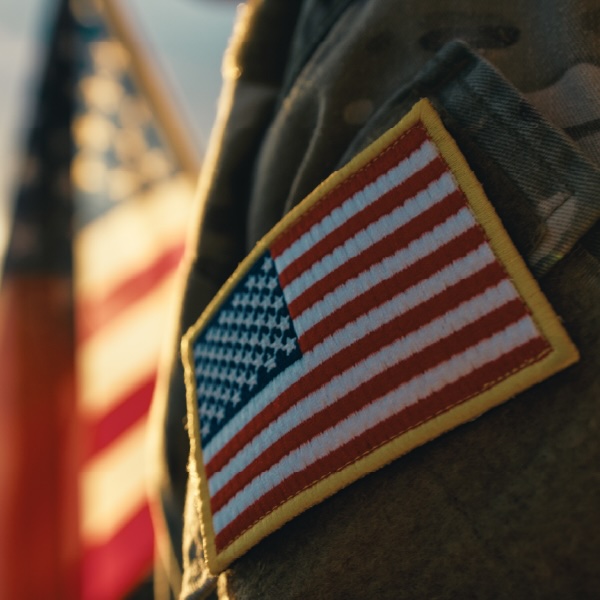What if the greatest threat to our veterans’ health isn’t on the battlefield, but in their pockets?
For decades, tobacco companies worked hard to associate their products with military service. They handed out free cigarettes to troops during wartime. They sponsored events on military bases. They sold products at steep discounts in commissaries and exchanges. The strategy was simple: Build loyalty among young service members and make smoking part of military culture.
Fast-forward to today, and we’re still seeing the results of that strategy play out. According to the Centers for Disease Control and Prevention (CDC), veterans are more likely to use tobacco than nonveterans. 48% of military veterans experiencing serious psychological stress report current use of tobacco products. And among veterans living in poverty or without health insurance, tobacco use rates are as high as 60%.
This isn’t just about addiction. It’s about how systems have failed to offer support, how military culture has normalized unhealthy coping mechanisms, and how easy access continues to undercut efforts to quit. And at its core, it’s about protecting the health and wellbeing of those who served to protect us.
Where Tobacco Use and Military Life Intersect
For many veterans, tobacco was a part of everyday life during service. Smoking breaks offered a rare moment of quiet. Sharing dip during deployment became a way to bond. And the military itself made it easy. For years, tobacco products were cheaper on base than anywhere else. Even after the Department of Defense (DOD) issued a policy requiring military stores to match local community prices, research showed that tobacco remained cheaper on base in practice. For all of these reasons, approximately 38% of current military smokers began using tobacco after they enlisted in military service.
Price is one of the most powerful factors in tobacco use. If products are affordable and accessible, people are more likely to continue using them. Even today, many base exchanges and commissaries sell cigarettes and smokeless tobacco at prices that are lower than nearby civilian retailers. According to a 2019 audit, the gap was as much as 40%.
The military remains a stronghold of smokeless tobacco use, in particular. Among younger enlisted troops, dip is often seen as a more discreet option during long shifts, field exercises or deployments where smoking isn’t possible. The DOD Health Related Behaviors Survey found that approximately 13% of active-duty service members use smokeless tobacco, significantly higher than the general population. This isn’t a harmless alternative. According to the National Cancer Institute, smokeless tobacco is linked to cancers of the mouth, esophagus and pancreas, and causes serious gum disease and tooth loss.
And that connection to cancer isn’t limited to smokeless tobacco. Tobacco, whether smoked or chewed, is the leading cause of preventable cancer and cancer deaths in the U.S. Tobacco use is currently associated with 16 different cancers, such as cancer of the lungs, throat, bladder and stomach. Veterans already face higher cancer risks due to service-related exposures. Tobacco only compounds that risk.
Tobacco companies know this. They also know that veterans are a trusted demographic. That’s why brands like JUUL launched campaigns offering deep discounts (e.g. $1 starter packs) to military personnel and first responders. Their “Heroes” program promised special pricing on e-cigarette starter kits and positioned JUUL as a tool for veterans to minimize risks associated with substance use. As public health experts have pointed out, the campaign was more about building brand loyalty than providing legitimate support. The program ended after criticism and scrutiny, but the message stuck: Veterans are still being targeted.
How the VA and DOD Are Responding
In the face of this, both the Department of Veterans Affairs (VA) and DOD have taken meaningful steps to address tobacco use. The VA implemented a smoke-free campus policy in 2019 that prohibits smoking and vaping on all VA hospital grounds. This was a major cultural shift, aligning the VA with more than 4,000 other smoke-free hospitals across the country.
The VA also expanded access to cessation tools. Veterans enrolled in VA care are screened for tobacco use annually and are offered both behavioral counseling and medication. The YouCanQuit2 plan, Quit VET telephone counseling line, SmokefreeVET text program and Stay Quit Coach mobile app are all free and tailored to veterans’ unique needs. These tools reflect a broader shift toward meeting veterans where they are, not just in person but through tech-based solutions that support quitting on demand.
Meanwhile, the military has raised the age for tobacco sales to 21 across all branches, a policy that went into effect in 2020. The Army Public Health Center and DOD Health Affairs continue to run programs that provide service members with resources to quit, including nicotine replacement therapies and peer support.
These policies are a step in the right direction. But culture often lags behind policy. And while cigarette smoking has declined in recent years, the use of e-cigarettes and nicotine pouches among young veterans and active-duty troops is on the rise. Nearly 18% of service members still smoke cigarettes, while more than 16% use e-cigarettes, according to the DOD Health Related Behaviors Survey.
Breaking the Stigma: Seeking Support to Quit
While policies and resources to support quitting are expanding, stigma remains a significant barrier for many veterans. Military culture often prizes toughness, resilience and self-sufficiency — traits that can make it harder for individuals to seek help when facing addiction.
For some veterans, tobacco use is not just a habit; it’s tied to identity, camaraderie and stress relief. Admitting a need for help can feel like a sign of weakness, and concerns about judgment from peers, leadership or health care providers may prevent veterans from accessing cessation programs.
In addition, misconceptions about quitting can reinforce stigma. Some veterans believe that nicotine is their primary coping tool, that quitting will worsen their mental health, or that they should be able to stop on their own. Without a supportive culture that normalizes cessation and provides tailored, veteran-led support, many continue to use tobacco even when they want to quit.
To truly support veterans, we must not only offer cessation resources but also work to shift cultural attitudes. This means integrating tobacco treatment into routine veteran health care, training providers to address stigma sensitively, and ensuring that seeking help for nicotine addiction is seen as an act of strength, not weakness.
What Needs to Happen Next
We know what works. Veterans are more likely to quit when they have access to and receive both counseling and medication. They’re more likely to try quitting when the price of tobacco is higher and tobacco is harder to access. And they’re more likely to stay quit when they’re supported by people who understand their experience.
To reduce tobacco use among veterans, we need to:
- Eliminate pricing loopholes that allow tobacco to be sold cheaply on base.
- Continue to scale up veteran-specific cessation tools, including peer-led models.
- Ensure every behavioral health and substance use program includes a plan for tobacco treatment.
- Invest in outreach that resonates with veterans’ values, identities and lived experiences.
Tobacco use is not just a health issue. It is a matter of honoring and protecting the wellbeing of those who have served. Supporting veterans in quitting tobacco is not just good medicine: It affirms their strength, protects their health and ensures they receive the comprehensive care they deserve.




